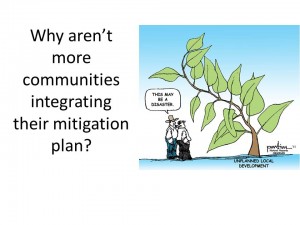I have been to my fair share of presentations on disaster-related issues. When I hear a particularly good presentation, I know it is good because I have a lot of others to which I can compare it. Sometimes local planners, emergency managers, and engineers, among others, can bring a certain parochial flavor to their presentations. I think this is usually the result of not having either the experience or the inclination to think beyond the set of problems and challenges immediately before them.
But there are also those who have thought bigger thoughts, figured out larger patterns, and validated them through observation and experience. Last week, at a conference in Broomfield, Colorado, north of Denver, I heard one such presentation that I thought gave listeners something serious to think about.
The Association of State Floodplain Managers, which is based in Madison, Wisconsin, was holding its Sixth Triennial Flood Mitigation and Floodproofing Workshop. I was invited to help present a 90-minute workshop on the integration of hazard mitigation into comprehensive planning, a subject I will address in a forthcoming blog. Before I do that, however, I thought it more important to discuss what Brian Varrella, an engineer and certified floodplain manager for the city of Fort Collins, Colorado, discussed in a plenary presentation based in part on his city’s experience with serious floods in September 2013.
Varrella did not settle for merely telling us about the extent of the flood and resulting damages in Fort Collins, and how the city is rebuilding again. He took the audience back to some neglected basics. In teaching graduate urban planning students about hazard mitigation and disaster recovery at the University of Iowa, I often try to do the same thing early in the course. I stress that all hazard events involve some very basic equation rooted in physics. Want a wildfire? Combine oxygen, fuel, and heat. Want to predict the direction of a flood? Think about gravity, and you will find the water, which inevitably flows downhill. Of course, the specific circumstances of any disaster require some knowledge of the local conditions, particularly topography, to make that understanding useful. But the basic equations never go away.
What differentiates a disaster from a natural event—what, for instance, turns a hurricane into a disaster—is the presence of the built environment and humans in the path of that event. A hurricane (typhoon) passing over an uninhabited island in the Pacific Ocean does not produce a disaster. The same storm assaulting Miami becomes a disaster. The difference is what we have built in harm’s way.
What if the conditions exist for several hazards simultaneously? That is the Colorado challenge that Varrella addressed. Wildfire, he noted, creates other problems from one disaster, in part by baking the soil when it is particularly intense. Subsequent thunderstorms cannot penetrate the now hardened soil, and instead carry vegetative and muddy debris downhill into the watershed, producing “muddy material that is opaque,” water that is heavy with silt. The result is a more intense flood. Colorado, Varrella noted, lost 10 people in last year’s floods; that was fortunately not even close to the record of 140 lives lost in the Big Thompson flood of the 1970s.
Yet some solutions commonly used to mitigate future damages elsewhere cannot always work because of Colorado’s steep terrain. Elevation, for instance, is commonly used in riverine and coastal floodplains to place the living area of a home above projected elevations of future floods, as determined by National Flood Insurance Program maps. But in mountainous terrain, watersheds can rapidly migrate in flash floods, washing out the toe of ledges beneath houses on hillsides. Elevation does nothing to restore the underlying stability of the soil, but significant setbacks from such ledges may help. Varrella suggested that Colorado borrow standards for such situations from other states with similar experiences, citing Vermont, New Mexico, and Washington. He noted that flood insurance rate maps (known as FIRMs) do not show all hazards. “We must find a new way of doing business,” he said. Maps that are static in time are not prone to show or predict such dynamic erosion.
It is always helpful when such a speaker has a set of recommendations for moving forward with a dynamic, complex problem, and Varrella did, so here goes:
• Create a framework for understanding wildfire and flood as cascading, related events.
• Reduce the human side of the disaster equation, for example, by requiring setbacks in the cases cited above.
• Treat wildfires as a prelude to the sequence of floods followed by erosion and debris.
• Change our hydraulic and hydrological practices to think in the fourth dimension of time; advocate for unsteady hydraulic models that reflect dynamic realities.
• Collaborate as a watershed among local governments. The watershed is the most efficient level at which to mitigate damages from wildfire and flooding; combine resources, stakeholders, and solutions.
• Communicate all natural hazards to the public. Establish flood warning systems before wildfires ever happen.
• Break the fire-flood-erosion cycle by managing forests as assets, not just resources.
• More helicopters, please; get eyes above the ground to see what’s happening on the ground in a timely fashion in order to save lives.
It’s a tall agenda, but a sensible one that is manageable if we focus on the problem. I think he’s clearly on the right track.
Jim Schwab

